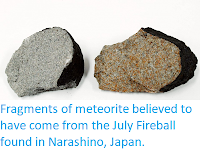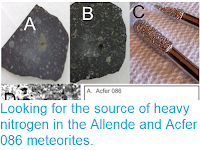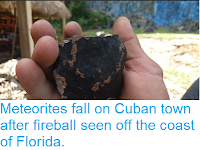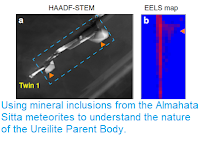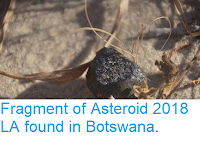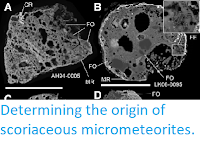The Iron Age is considered to have begun when people started smelting iron from iron oxide ores. However, some iron artefacts predate this, having been produced from a source which did not require smelting: meteoric iron. In the Old World, Bronze Age meteoric iron artefacts are known from Turkey, Greece, Syria, Iraq, Lebanon, Egypt, Iran, Russia, China, and Poland. To date, the entire complement of Bronze Age meteoric iron artefacts from Europe comprises two rings and an amulet from Greece, a pair of bracelets from Czestochowa-Rakowa in Poland, and an iron axe from Wietrzno, also in Poland. Attempts have recently been made to locate other meteoric iron objects in archaeological collections, using X-ray fluorescence analysis, concentrating on areas where meteoric iron is thought likely to have been available. One such potential source is the Twannberg iron meteorite strewn field in the Jura Mountains of Switzerland, which has led archaeologists to re-examine many Bronze Age artefacrs in Swiss museum collections.
In a paper published in the Journal of Archaeological Science on 25 July 2023, Beda Hofmann of the Naturhistorisches Museum Bern and the Institute of Geological Sciences at the University of Bern, Sabine Bolliger Schreyer of the Bernisches Historisches Museum, Sayani Biswas and Lars Gerchow of the Paul Scherrer Institute, Daniel Wiebe, Marc Schumann, Sebastian Lindemann, and Diego Ramírez Garíca of the Physics Insitute at the University of Freiburg, Pierre Lanari, also of the Naturhistorisches Museum Bern, Frank Gfeller, also of the Naturhistorisches Museum Bern and the Institute of Geological Sciences at the University of Bern, Carlos Vigo, Darbachan Das, and Fabian Hotz, also of the Paul Scherrer Institute, Katharina von Schoeler of the Institute for Particle Physics and Astrophysics at ETH Zürich, Kuzihiko Ninomiya of the Institute of Radiation Sciences at Osaka University, Megumi Niikura of the RIKEN Nishina Center for Accelerator Based Science, Narongrit Ritjoho of the School of Physics at Suranaree University of Technology, and Alex Amato, again of the Paul Scherrer Institute, describe the discovery of a Bronze Age meteoric iron arrowhead in the collection of the Bernisches Historisches Museum.
The arrowhead (specimen number A/7396), was recovered from the Mörigen Pile Dwelling, a Bronze Age stilt house settlement attributed to the Urnfield Culture, on Lake Biel in Bern Canton, which is about 4-8 km south of the Twannberg iron meteorite strewn field. The Mörigen site was discovered by local fishermen in 1843, and was the subject of various amateur excavations until 1873, when the Bern government banned such activities, and arranged for a formal exploration of the site under the leadership of archaeologist Eduard von Jenner and geologist Edmund von Fellenburg. Exactly when arrowhead A/7396 was found is unclear, but it is thought to have been recovered during Jenner and Fellenburg's excavations in 1873 and 1874. It was first observed that the arrowhead was iron rather than bronze by Monika Bernatzky-Goetze in 1987, during a wider examination of arrowheads from Mörigen, though she made no further investigation of it at that time. It has a mass of 2.904 g, and measures 39.3 mm long, 25 mm wide, and 2.6 mm wide, and has a triangular blade with a 13 mm tang.
Hofmann et al. carried out a metallurgical comparison of arrowhead A/7396, comparing it to two fragments of the Twannberg Meteorite, TW1 (NMBE 36467) and TW934 (NMBE 43747), but found that it was metallurgically quite distinct from these, and therefore derived from a different meteorite. The arrowhead was also examined by light microscopy, X-ray micro-computer tomography, muon induced X-ray emission spectography, scanning electron microscopy, gamma spectroscopy, and Ramen spectroscopy.
The arrowhead is comprised of rust covered iron with a very laminated texture, in places patches of sediment can still be seen attached to the surface, and very small amounts of unrusted iron are visible within a crack on the surface. The surface of the arrowhead has grinding or scratch marks in several places, which are beneath the attached organic material and sediment particles where these are found on the same part of the arrowhead.
X-ray tomography revealed that the rust layer, although covering most of the sirface, is very thin (less than 0.1 mm). The crack observed visually can be seen to extend across almost the whole width of the arrowhead in X-ray tomography, and is largely filled with fine-grained silt sediment. -ray tomography also showed the arrowhead to be of uneven thickness, being 1.2 mm thick on one side, while the other is only 0.6 mm thick. The metal has a pronounced layering parallel to the frontal plane of the arrowhead, something which would not be expected in an iron meteorite, and which is therefore presumed to be an artefact of the way in which the arrowhead was made.
The Mörigen arrowhead is very flat, and has probably had its thickness increased somewhat by oxidation. This is not a natural shape for meteors or meteor fragments, suggesting that the metal has been flattened as well as being sharpened. Such working of the metal is a plausible origin for the laminations visible in the X-ray tomograph images of the arrowhead, which is probably a deformed Widmanstätten pattern (Widmanstätten patterns are interleaving of kamacite and taenite bands found in nickel-iron meteorites, where they are believed to be formed by very slow cooling of the metal, probably over millions of years). Similar patterns have been observed in artefacts from Greenland, which are known to have been made by cold working of material from the Cape York meteorite. These Greenland artefacts also have a very flat form, and a layered microstructure made from flattening of large kamacite and taenite grains. Hot working is also a possibility, though heating to above about 700° would probably result in the loss of the banding due to recrystallization. The grinding marks seen on the surface of the arrowhead in places may be a result of this working process. Thus, although the arrowhead is of a similar shape to the bronze arrowheads also found at Mörigen, it appears to have reached this shape via quite a different working process.
The oxidised surface of the arrowhead is a less than ideal target for X-ray fluorescence spectroscopy, and is likely to be responsible for the variation in nickel concentrations across the surface of the object; up to 22%, which is improbable on an unoxidized surface, and probably results from element partition during the corrosion process. Muon induced X-ray emission spectography, which can penetrate the surface of objects, found that the nickel content increased and stabilised with depth in both the arrowhead and meteorite fragment TW934 (which also has an oxidised surface) but not meteorite fragment TW1, which does not. Iron, nickel, cobalt, gallium, and germanium, all typical components of iron-nickel meteorites, were all detected by X-ray fluorescence spectroscopy, as were arsenic and copper, which are much more unusual. High levels of lead were found on the parts of the arrowhead with white numbering, implying that a lead-oxide based paint was used.
Scanning electron microscopy revealed the presence of bith taenite and kamacite, which are nickel-rich and nickel-poor phases found in iron-nickel meteorites. Some organic material was present on the surface, and were sediment particles, showing calcium, carbon, oxygen, and silicon, which would fit with a mixture of calcium carbonate and quartz. The pigment of the label was found to contain bith leand and tin.
Gamma spectrometry of the arrowhead was able to detect the presence of the isotopes aluminium²⁶, potassium⁴⁰, uranium²³⁸, thorium²²⁸, cobalt⁶⁰, and cesium¹³⁷. Ramen spectroscopy of the organic material produced a signal typical of a tar-like material, which was probably birchwood tar used to attach the arrowhead to the arrow.
The presence of aluminium²⁶ strongly supports the meteoric origin of the metal suggested by the presence of nickel, cobalt, gallium, and germanium, and the ratios of iron to nickel and nickel to cobalt. The presence of the Widmanstätten patterns and taenite rule out an origin from the Twannberg Meteorite, fragments of which have only ever been found to contain kamacite. The concentrations of nickel and germanium in the metal are consistent with the parent meteor having mostly likely been an IAB type iron meteorite, such as the Cañon Diablo Meteorite from Arizona or the Campo de Cielo meteorites from Argentina. The composition of the metal could also correspond to an IC group meteorite, although these are much rarer, with only 13 known examples, none of them from Europe.
Aluminium²⁶ is a cosmogenic isotope, found close to the surface of iron-nickel Solar System bodies, where it is formed by cosmic rays bombarding magnesium²⁶, the element to which it also decays, with a half-life of 717 000 years. This short half-life means that aluminium²⁶ and magnesium²⁶ reach an equilibrium point, witht the proportion of aluminium²⁶ decreasing deeper within the body. The proportion in the metal of the Mörigen arrowhead implies that it was at a depth of about 40 cm when it was in the parent body, implying a meteorite with an original diameter of about 80 cm. Such a meteorite would have had a minimum mass of about two tonnes.
The metal of the arrowhead is likely to have undergone some modification since it arrived on Earth. The most obvious modification is the layer of rust (iron oxide) which has formed on its surface, but the presence of copper and arsenic, elements not usually found in nickel-iron meteorites, is probably a result of Human actions, possibly originating when the metal was worked with tools used to work on bronze, but also quite possibly a result of being stored with bronze items.
The chemical and isotopic composition of the Mörigen arrowhead suggests that it derived from an IAB type meteorite with a minimum mass of about two tonnes. Three large IAB meteorites with compositions compatible with the Mörigen arrowhead are known from Europe; the Bohumilitz Metoerite from the Czech Republic, the Retuerte de Bullaque Meteorite from Spain and the Kaalijarv Meteorite from Estonia. Of these, the Kaalijarv is known to have been particularly large, producing a series of craters, the largest of which, the Kaalijärv Crater on the island of Saarema in Estonia, is 110 m in diameter. This object is thought to have had an original mass of several hundred tonnes, most of which was destroyed during the impact, leaving only small fragments of shrapnel. A piece of shrapnel from the Kaalijarv Meteorite would be a plausible source for the metal of the Mörigen arrowhead, although it is possible that the metal was broken off a larger mass, with other iron artefacts (now lost to us) being made from the remaining material. About 10 kg of material has been recovered from the Kaalijarv Meteorite to date, with dating based upon the stratigraphic location of these fragments suggesting the meteorite fell between 1870 and 1440 BC. This Bronze Age date, combined with the parent body having been sufficiently large to produce a fragment with the aluminium²⁶ signature seen in the Mörigen arrowhead, and the fact that it fell in an area known to have been inhabited during the Bronze Age, and therefore would have been observed, makes the Kaalijarv Meteorite the most likely source for the material used to make the arrowhead.
However, this does not rule out other meteorites, such as Bohumilitz or Retuerta de Bullaque, or even an unknown impactor, as sources of the material. The Morasko IAB strewn field in Poland, which has been dated to about 3000 BC and which produced craters up to 90 m in diameter, can be ruled out, as all recovered fragments of this meteorite have much higher levels of germanium (about 500 parts per million) than seen in the Mörigen arrowhead. The Wietrzno Axe and Czestochowa-Rakowa Bracelets are close in time to the Mörigen arrowhead, but have much higher nickel contents, suggesting that they were made with material from a different meteorite.
A search for meteoric iron artefacts near to the Twannberg strewn field produced only a single item, and this was clearly derived from a different meteorite. This suggests that Bronze Age peoples were not aware of the Twannberg Impact, and had no means of detecting and utilizing metal from buried fragments of this object. The artefact uncovered, an iron arrowhead from the Mörigen Pile Dwelling in Bern Canton appears to have been derived from the Kaalijarv Meteorite, which fell in Estonia in about 1500 BC, implying that meteoric iron was a commodity traded across Europe before 800 BC (the approximate age of the Mörigen settlement), with the arrowhead, or the metal from which it was made, apparently having been transported about 1600 km.
Since it is highly unlikely that only a single artefact would have been made from a source such as the Kaalijarv Meteorite once people were aware of it, there is a distinct possibility that other objects made from iron derived from this source are present in archaeological collections elsewhere in Europe, and possibly beyond. While it is possible that larger objects were made from this source, the highly fragmented nature of the material makes it more likely that most artefacts were small, and out current understanding of the ability of Bronze Age people to work iron, also suggests any objects will be very flat, giving a clear set of parameters for searching archaeological collections for more objects.
See also...
Follow Sciency Thoughts on Facebook.
Follow Sciency Thoughts on Twitter.




























